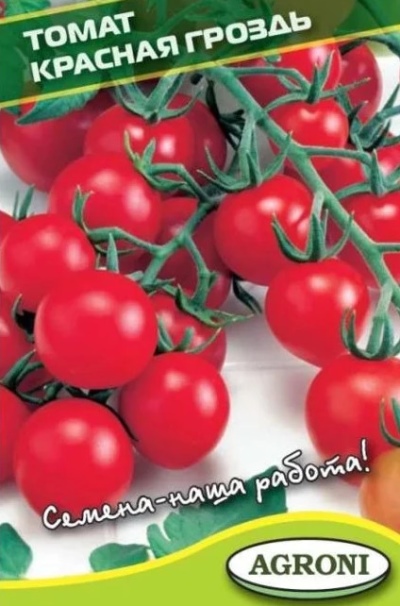
- Authors: Nalizhyty V. M., Kochkin A. V., Nasrullaev N. M., Zotov M. V. (Agroni LLC)
- Year of approval: 2008
- Category: grade
- Growth type: determinant
- Appointment: fresh consumption, for whole fruit preservation
- Ripening period: early
- Ripening time, days: 100-105
- Growing conditions: for open ground, for film greenhouses
- Transportability: high
- Bush height, cm: 30-40
The red bunch is a determinant tomato variety successfully cultivated in film greenhouses and open field. It's versatile, perfect for making summer salads or preserving whole fruits. The variety is transportable, great for commercial cultivation.
Breeding history
The variety was obtained by the specialists of Agroni LLC and appeared in the State Register in 2008. The metropolitan company applied for admission to use back in 2006, the rest of the time was spent on testing.
Description of the variety
The bush is compact, the average height in the open field does not exceed 30-40 cm, in the greenhouse it can stretch higher. Low foliage. Fruiting occurs with brushes. The inflorescences of the plant are intermediate, the first is formed above the place of attachment of 6-7 leaves. The bushes themselves are strong and strong, can grow successfully without props until the beginning of fruiting.
Tomato tops have a characteristic "potato" look. It is green, without pubescence. The root system is tenacious, rapidly growing.
The main qualities of the fruit
Fruits such as cherry, collected up to 100 pieces in a bunch, in an unripe state they are green, with a characteristic dark spot at the stalk. Ripe tomatoes are red, rounded, weighing up to 17 g each. The fruit has a thin, but resistant to cracking, silky skin with a glossy sheen, tender pulp with a pleasant consistency.
Taste characteristics
The Krasnaya bunch has excellent taste properties. The juicy pulp leaves a pleasant sensation. It is sweet with a balanced mix of freshness, sweetness and acidity.
Ripening and fruiting
Early variety. Its ripening time varies within 100-105 days. Fruiting is long, the harvest is harvested from July to October.
Yield
The collection volumes reach 10 kg / sq. m. According to this indicator, the variety is high-yielding.
The timing of planting seedlings and planting in the ground
Tomato is ready for transfer to open ground in May-June. Seedlings are sown in March; greenhouses can be planted earlier. On average, 55-70 days should pass from the emergence of seedlings to the transfer of the bush to the final place of growth.

Growing tomato seedlings is an extremely important process, because it largely depends on whether the gardener will be able to harvest at all. All aspects must be taken into account, from seedbed preparation to planting in the ground.
Landing scheme
It is considered optimal to maintain the distance between plants in the range of 70 × 40 cm. This scheme allows you to place 2-3 plants per 1 m2.

Growing and care
The variety is distinguished by its undemanding care. The garter can be performed already at the fruiting stage, but pinching cannot be neglected.In addition, when growing, it is important to choose sunny areas that promote early ripening of fruits. The correct soil is fertile, light, and loose. It's a good idea to choose a ridge on which cucumbers, carrots, and legumes were located last season.
Pinching is carried out with the appearance of 4-6 inflorescences. From this point on, it is necessary to control the growth of both lateral shoots and the apical part. Due to the significant mass of bunches at the fruiting stage, tomatoes need props. They are installed individually.
To increase the yield of tomatoes Red bunch, top dressing is used. Mineral or organic fertilizers are suitable. The first is carried out before the formation of ovaries begins. For the solution, chicken manure or manure is taken - 1 kg per bucket of water. Top dressing is applied by watering at the root, so as not to damage the foliage.
The next fertilization can also be natural. At the time of the beginning of fruiting, an herbal infusion rich in nitrogen is suitable for these purposes. Potassium-phosphorus mineral complexes can be used to improve the taste. Will be useful during the growing season and foliar dressing using a solution of 25 g of urea, 1 g of manganese and a bucket of warm water.




A plant needs different micronutrients at each stage of growth. All fertilizers can be divided into two groups: mineral and organic. Folk remedies are often used: iodine, yeast, bird droppings, eggshells.
It is important to observe the rate and period of feeding. This also applies to folk remedies and organic fertilizers.
Disease and pest resistance
Tomato Red bunch is resistant to late blight. This variety has a fairly high immunity against common diseases of nightshade crops. It is practically not affected by powdery mildew. When grown in greenhouses, it may require preventive treatments and ventilation.


Resistant to adverse weather conditions
The variety tolerates long periods without sun well. In the open field, it can successfully withstand the extremes of day and night temperatures. It tolerates excess moisture well. Prolonged periods of bad weather do not affect the rate of fruiting.
Review overview
The opinion of gardeners about the Red bunch tomatoes looks quite positive. Buyers note that this variety gives good seed germination. The compact size of the bushes allows you to grow them not only in a greenhouse or garden bed, but also on a balcony. Gardeners often mention that the fruits are the size of an average cherry, ripen together without ripening, and demonstrate good keeping quality.
The disadvantage of the variety is its popularity. Many unscrupulous firms send out substandard seeds under the guise of a Red Bunch. In sachets comes across a re-grading.

























































































